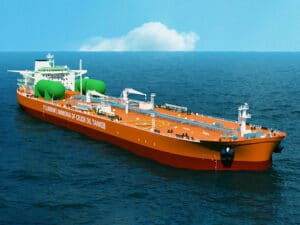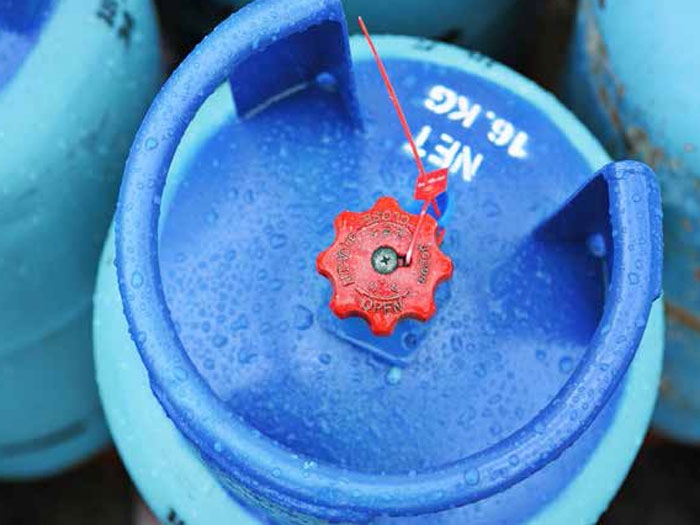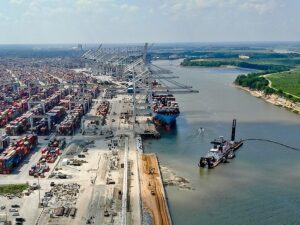
DNV GL looks at future marine fuel mix
Written by Nick Blenkey
JANUARY 28, 2014 — DNV GL has released a position paper that looks at what alternative fuels ships will be burning between now and 2050. And while LNG is expected to be an early success, diversification will increase.
The main drivers for the use of alternative fuels are the desire to reduce greenhouse gas emissions and the need to meet upcoming air pollution requirements.
“The global merchant fleet currently consumes around 330 million tonnes of fuel annually, 80-85 per cent of which is residual fuel with high sulfur content,” says Christos Chryssakis, senior researcher DNV GL and position paper project manager. “Shipping must change, and we must contribute technical measures, operational measures and alternative fuels to meet the environmental challenges we are tackling.”
Over the next four decades, it is likely that the energy mix will be characterized by a high degree of diversification, says Mr. Chryssakis. “LNG has the potential to become the fuel of choice for all shipping segments provided the infrastructure is in place, while liquid biofuels could gradually also replace oil-based fuels.”
Electricity from the grid is most likely to be used more and more to charge batteries for ship operations in ports and will also be used for propulsion. Other energy storage technologies that can find application in shipping in the future include flywheels, supercapacitors and thermal energy storage devices.
“Electrification has generated strong interest, particularly for ship types with frequent load variations. Significant growth in hybrid ships, such as harbor tugs, offshore service vessels, and ferries should be expected after 2020, and further applications for the technology may be applied to power cranes for bulk carriers or even in ports. After 2030, improvements in energy storage technology will enable some degree of hybridization for most ships,” says Mr. Chryssakis.
For large, deep sea vessels, hybrid systems will be used for auxiliary systems, maneuvering and port operations.
Renewable electricity could also be used to produce hydrogen, which in turn can be used to power fuel cells to provide auxiliary or propulsion power. Hydrogen is the smallest and lightest of all gas molecules and offers the best energy-to-weight storage ratio of all fuels. However, hydrogen as fuel can be difficult and costly to produce, transport, and store.
“Significant improvements in technology, accompanied by cost reductions are required if fuel cells are to become competitive for ships,” says Mr. Chryssakis.
In the long term, short sea shipping is expected to take advantage of locally produced fuels such as biogas, biodiesel and methanol.
Biofuels are flexible: they can be mixed with conventional fossil fuels to power conventional internal combustion engines, while biogas produced from waste can be used to replace LNG. A number of liquid fuels can be used in dual fuel engines as substitute for oil.
Typically, a small quantity of marine fuel oil is used as pilot fuel to initiate the ignition process, followed by combustion of the selected alternative fuel. Some of the fuels that can be used are liquefied petroleum gas (LPG –a mixture of propane and butane), methanol, ethanol, and di-methyl ether (DME). Most of these fuels offer significant reductions of NOx and particulate matter emissions and are sulfur free and can be used for compliance with ECAs regulations.
In July 2013 DNV released rules for using low flashpoint liquid (LFL) fuels, such as methanol, as bunker fuel. Methanol has a relatively low flashpoint, is toxic when it comes into contact with the skin or when inhaled or ingested and its vapor is denser than air. As a result of these properties, additional safety barriers are required. The new mandatory notation LFL FUELLED covers aspects such as materials, arrangement, fire safety, electrical systems, control and monitoring, machinery components and some ship segment specific considerations.
DEEP SEA SHIPPING HAS SPECIFIC NEEDS
Deep sea shipping needs globally available fuels and so will tend towards LNG and biodiesel. LNG uptake is expected to grow fast in the next five to 10 years, first on relatively small ships operating in areas with developed gas bunkering infrastructure where LNG prices are competitive to HFO prices. They will then be followed by larger ocean-going vessels when bunkering infrastructure becomes available around the world.
Experimentation with biofuels has already started on large vesselsHowever, advances in the development of biofuels derived from waste or algae will depend on the price of oil and gas. Though, biofuels will have only limited penetration in the marine market in the next decade, they are set to play a larger role by 2030 — if significant quantities can be produced sustainably and at an attractive price.
TAKING A WELL TO PROPELLER VIEW
Mr. Chryssakis says that an evaluation of well to propeller greenhouse emissions, rather than just shipboard potential to reduce emissions, demonstrates some major drawbacks for some of the options. For example the availability of land to grow biofuels is a significant barrier to their widespread use with an area the size of Greece required to produce 50 million tons of biodiesel.
While vessels equipped with sails, wind kites or solar panels may be able to supplement existing power generating systems, the relative unreliability of these energy sources makes them ill-suited for deep sea transport or operations in some latitudes with seasonal weather conditions.
Besides IMO rules and ISO standards, development of appropriate rules and recommended practices is necessary for the safe implementation of any of these technologies in the future. “There is no doubt that adopting new technologies is likely to be an uncomfortable position for shipowners. DNV GL is leading the way through our technology qualification processes which are designed to ensure that new technologies work as expected,” says Mr Chryssakis.
Download the position paper HERE





Leave a Reply
You must be logged in to post a comment.